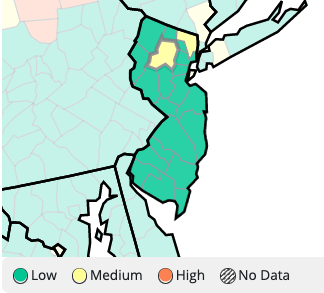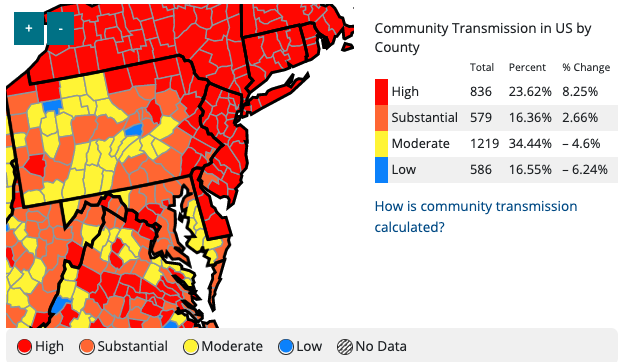Long Valley Area's COVID Levels Increase: What To Know
LONG VALLEY, NJ — COVID-19 has not left the Long Valley area, which may carry a greater virus risk than most of the state. Morris County is one of two in New Jersey with "medium" COVID-19 community levels, while the rest remain low, according to the Centers for Disease Control & Prevention.
The CDC's new framework for measuring each county's level of risk — implemented in late February — focuses on patients hospitalized with COVID and the amount of space remaining in those hospitals. Previously, the agency measured COVID risk based on the amount of virus spreading within each county and what portion of the lab tests turn up positive.
Based on the new framework, Morris and Bergen Counties carry "medium" COVID risk, while the CDC places the rest of New Jersey in the low category. Meanwhile, Atlantic Health Systems tightened its visitor restrictions Monday because of increased COVID cases in its hospitals' communities. Read more: Morristown Medical Center Limits Visitors As COVID Cases Rise

The CDC, under its new method of measuring COVID risk, does not advise people to mask up until communities reach "high" activity levels. But hospitalizations represent a lagging indicator of the virus's presence, following increases in transmission and cases. Critics of the CDC's approach say the agency moved the goalposts to justify political missions to get people back to normal sooner than is safe.
"What it looks like is quite literally a changing of thresholds in order to justify a policy that I think assumes way too much risk," Jessica Malaty River, an epidemiologist at the Pandemic Prevention Institute, told NPR.
Morris County has a case rate of 239.1 people per 100,000 in the past week — the third-highest in New Jersey. Case rates of 200 or more put a county in at least the "medium" category. But only seven people per 100,000 in Morris County were admitted to the hospital for COVID in the past week, with COVID patients occupying only 1.3 percent of local hospital beds.
The county would need more than 10 COVID hospitalizations per 100,000 people and more than 10 percent of hospital beds occupied by patients with the virus for the CDC to raise its risk level to "high."
Ninety-five percent of Morris County residents 5 and older have received at least one dose of the COVID vaccine — tied for the highest rate in New Jersey.
But it may be harder to accurately determine case totals. The Institute for Health Metrics and Evaluation — an independent research institute — believes only 7 percent of positive cases in the United States get detected. The institute raised concerns that the recent rise in at-home COVID testing leaves many positive results unreported.
But one color-coded CDC map, which uses the agency's prior methodology for determining community risk, places almost all of New Jersey in the high end of community transmission.

According to the previous metrics, people in almost all New Jersey counties should mask in indoor, public spaces, stay up to date on vaccinations, get tested if they have symptoms and take additional precautions if they have a high risk for severe illness.
The new framework suggests Morris County residents should do the following:
Stay up to date with COVID-19 vaccines and boosters.
Maintain improved ventilation throughout indoor spaces when possible.
Follow CDC recommendations for isolation and quarantine, including getting tested if you are exposed to COVID-19 or have symptoms of COVID-19.
People who are immunocompromised or at higher risk for severe disease should:
Talk to their health care provider about whether they need to wear a mask and take other precautions (testing, for instance).
Have a plan for rapid testing if needed, such as having home tests ready.
Talk to their health care provider about whether they're a candidate for treatments such as oral antivirals, PrEP and monoclonal antibodies.
Before you go:
Send a news tip or correction to: russ.crespolini@patch.com
Subscribe to your local Patch newsletter.
Learn more about posting announcements or events to your local Patch site.
Long Valley Area's COVID Levels Increase: What To Know originally appeared on the Long Valley Patch
